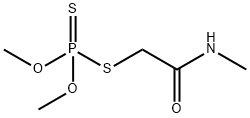CHEMICAL AND PHYSICAL PROPERTIES
| Physical Description | Dimethoate appears as a white crystalline solid, with a camphor-like odor, white to grayish crystals for technical product. This material is a contact and systemic organophosphate insecticide effective against a broad range of insects and mites when applied on a wide range of crops. It has not been produced in the U.S. since 1982. (EPA, 1998) |
|---|---|
| Color/Form | White crystalline solid |
| Odor | CAMPHOR-LIKE ODOR |
| Boiling Point | 243 °F at 0.1 mmHg (NTP, 1992) |
| Melting Point | 125 °F 113 to 117 °F for technical product. (EPA, 1998) |
| Flash Point | 124 °F (EPA, 1998) |
| Solubility | 1 to 10 mg/mL at 75 °F (NTP, 1992) |
| Density | 1.277 at 149 °F (EPA, 1998) - Denser than water; will sink |
| Vapor Pressure | 8.5e-06 mmHg at 77 °F (EPA, 1998) |
| LogP | log Kow = 0.78 |
| Stability/Shelf Life | The biological activity remains practically unvaried for 2 yr under environmental conditions, provided stored in unopened and undamaged original containers, in shaded, cool, well-aired places. ... Crystals may form in formulations stored at < 32 °F/0 °C. Stable a minimum of 1 yr at < 25-30 °C/77-86 °F. |
| Decomposition | When heated to decomposition it emits very toxic fumes of /nitrogen, phosphorous, and sulfur oxides/. |
| Corrosivity | Slightly corrosive to iron |
| Surface Tension | 47.8 mN/m |
| Refractive Index | Index of refraction: 1.5334 at 65 °C/D |
| Collision Cross Section | 139.9 Ų [M+H]+ [CCS Type: TW, Method: Major Mix IMS/Tof Calibration Kit (Waters)] |
| Kovats Retention Index | 1690 1727 1707 1733 1690 1720 1682.1 1720 1677.2 1696.8 1713.3 1702.5 1710 1710 1720 1733 1701.9 1675 1725 1693.2 1729.1 1685.3 1708.5 |
| Other Experimental Properties | Relatively stable in aqueous media at pH 2-7. Hydrolyzed in alkaline solutions. Photostability half-life >175 days at pH 5. Decomposes on heating, forming the O,S-dimethyl analogue |
| Chemical Classes | Pesticides -> Organophosphate Insecticides |
SAFETY INFORMATION
| Signal word | Danger |
|---|---|
| Pictogram(s) |
 Skull and Crossbones Acute Toxicity GHS06 |
| Precautionary Statement Codes |
P264:Wash hands thoroughly after handling. P264:Wash skin thouroughly after handling. P270:Do not eat, drink or smoke when using this product. P280:Wear protective gloves/protective clothing/eye protection/face protection. P301+P310:IF SWALLOWED: Immediately call a POISON CENTER or doctor/physician. |
COMPUTED DESCRIPTORS
| Molecular Weight | 229.3 g/mol |
|---|---|
| XLogP3 | 0.8 |
| Hydrogen Bond Donor Count | 1 |
| Hydrogen Bond Acceptor Count | 5 |
| Rotatable Bond Count | 5 |
| Exact Mass | 228.99962259 g/mol |
| Monoisotopic Mass | 228.99962259 g/mol |
| Topological Polar Surface Area | 105 Ų |
| Heavy Atom Count | 12 |
| Formal Charge | 0 |
| Complexity | 191 |
| Isotope Atom Count | 0 |
| Defined Atom Stereocenter Count | 0 |
| Undefined Atom Stereocenter Count | 0 |
| Defined Bond Stereocenter Count | 0 |
| Undefined Bond Stereocenter Count | 0 |
| Covalently-Bonded Unit Count | 1 |
| Compound Is Canonicalized | Yes |
PRODUCT INTRODUCTION
description
Dimethoate appears as a white crystalline solid, with a camphor-like odor, white to grayish crystals for technical product. This material is a contact and systemic organophosphate insecticide effective against a broad range of insects and mites when applied on a wide range of crops. It has not been produced in the U.S. since 1982. (EPA, 1998)
